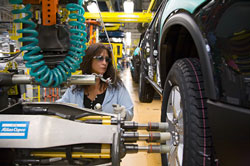Changing the Auto Industry from the Wheels Up
The problems of the U.S. auto industry call for radical solutions.
This is a web-only article from the website of Dollars & Sense: The Magazine of Economic Justice available at http://www.dollarsandsense.org

This is a web-only article, available only at www.dollarsandsense.org.
Subscribe Now
at a 30% discount.
Intro | Pt. I | Pt. II | Pt. III | Pt. IV | Pt. V | Pt. VI | Full article

Photo by Jim West
Part III: Buying the Assets
The government could have bought the assets of GM or Chrysler as an alternative to either making bailout loans or buying the company lock, stock, and barrel.
GM and Chrysler have considerable tangible assets (factories, machinery, and inventories), holdings in other companies (like GM’s stake in the consumer-finance company GMAC), cash reserves (dwindling fast), and so-called intangible assets (brand names, however tarnished). They also have vast liabilities (debts)—to bondholders, suppliers, warranty holders, current workers, and retirees. Had the government bought the companies, it would have bought both the assets and the liabilities.
The government has attempted to broker a process in which the two companies’ liabilities would be greatly reduced. As a condition of the bailouts, the government pushed GM and Chrysler to get concessions from both bondholders and the UAW. [Note 37] (The labor concessions have involved cuts in future wages and benefits, along with massive layoffs, in addition to reductions to past obligations. [Note 38]) If the government had bought a controlling stake in either company, it could have sought concessions from creditors (much as it has pushed the two companies to do). Some past nationalizations, such as Conrail, have also imposed harsh austerity measures on workers, so nationalization would not necessarily have been a panacea for workers. [Note 39]
Alternatively, the government could have bought the assets of GM or Chrysler rather than buying the company lock, stock, and barrel. In principle, it could have done this without waiting for them to burn through their remaining cash (plus the bailout funds) and declare bankruptcy. (Bankruptcy entails a great deal of uncertainty, and is usually dreaded by unions since it has been used historically by companies to cancel collective-bargaining agreements.) In late March, the Obama administration was considering plans under which both GM and Chrysler would be split into two companies, a “bad” company that would be liquidated and a viable “good” company (including most of the valuable assets) that would continue to operate. In the case of GM, the New York Times reported, most of the undesirable divisions and liabilities would be “left in the old company,” to be subsequently sold off and used, along with proceeds from the sale of its valuable components, to pay off creditors. A new company, “financed by the government,” would buy GM’s valuable divisions and assets. [Note 40] In the case of Chrysler, the administration’s plan aimed for Fiat to buy the “good” company. [Note 41] In neither case was the administration’s plan for the government to own the new company, though there is no reason in principle that this could not have been the goal.
The government could also have bought the assets of one of the companies in the event of bankruptcy and liquidation. Bankruptcy can lead to a company’s “reorganization,” in which case some or all of its debts and contracts may be voided, or can end in the liquidation of the company’s assets. The liquidation of a company means that the company ceases to exist, but not that its assets cease to exist—they are liquidated, not liquefied! The assets are sold off, and the proceeds are used to pay off at least some creditors. In principle, if the government wanted to get auto workers back to work producing cars, it could have bought the factories and machinery and paid the workers to produce cars. If it wanted to get them back to work producing something else, it could have still bought these factories and machinery and retooled for some other kind of production.
When a bankrupt company is liquidated, which creditors will be paid off first is always an issue. Neither Chrysler nor GM has enough assets to pay off all their creditors, so in the event of the liquidation of either company, some creditors would receive nothing. In a recent forum in the New York Times, UCLA law professor Lynn M. LoPucki argues that bankruptcy law gives workers “priority over the claims of ordinary creditors, including the bondholders, the suppliers, and the dealers.” In practice, however, who gets paid off first (or at all) often depends on the leanings of the bankruptcy court. [Note 42] No matter who bought the assets in a liquidation (the government or a private buyer), the concern would be that the proceeds would be used to pay off bondholders, and leave workers and retirees in the lurch.
The creditors who balked at Chrysler’s restructuring plan were “secured” lenders, meaning that they would have had first claim on the company’s assets, and so were holding out for either a liquidation or a better deal. [Note 43] As of early May, a bankruptcy judge decided that Chrysler’s restructuring could go ahead as planned, despite the creditors’ objections, so a liquidation does not seem likely. [Note 44] (As some of the bondholders abandoned the cause, the holdout group dissolved. [Note 45]) It is still possible that some GM creditors will oppose its proposed restructuring, and hold out for a liquidation. Were the government to buy the assets of a bankrupt company, it should ensure, either through the terms of the particular bankruptcy or through new legislation covering all bankruptcies, that obligations to workers and retirees are honored before obligations to bondholders. In practice, this would mean that bondholders would be “wiped out.”
Intro | Pt. I | Pt. II | Pt. III | Pt. IV | Pt. V | Pt. VI | Full article
End Notes:
37. David E. Sanger, David M. Herszenhorn, and Bill Vlasic, Bush Aids Detroit, but Hard Choices Wait for Obama, New York Times, December 19, 2008.
38. Obama Administration Auto Restructuring Initiative: Chrysler-Fiat Alliance, The White House, Office of the Press Secretary, April 30, 2009; Jim Puzzanghera, Chrysler’s major bondholders slash its debt, Los Angeles Times, April 29, 2009; Alex P. Kellogg and Kris Maher, UAW to Get 55% Stake in Chrysler for Concessions, Wall Street Journal, April 28, 2009; Steven Mufson, GM’s New Road Map: Partial Nationalization, Washington Post, April 28, 2009; John D. Stoll and Sharon Terlep, GM Offers U.S. a Majority Stake, Wall Street Journal, April 28, 2009.
39. Louis Uchitelle, Railroad Bailout May Offer a Model for Detroit, New York Times, March 15, 2009.
40. Brian D. Glater, U.S. Hopes to Ease GM to Bankruptcy, New York Times, March 31, 2009; Jeffrey McCracken, Monica Langley, and John D. Stoll, Bankruptcy Leads Possible Plans for GM, Chrysler, Wall Street Journal, March 30, 2009.
41. Jeffrey McCracken, Monica Langley, and John D. Stoll, Bankruptcy Leads Possible Plans for GM, Chrysler, Wall Street Journal, March 30, 2009.
42. Lynn M. LoPucki, Legal Rights vs. Reality, in: Room for Debate: “Auto Workers: Rescue Them or Not?,” New York Times, March 9, 2009.
43. Michael J. de la Merced, A Road Map to a Chrysler Bankruptcy, New York Times, April 30, 2009.
44. Michael J. de la Merced and Jonathan D. Glater, Plan to Sell Chrysler to Fiat Clears Bar, New York Times, May 5, 2009.
45. Michael J. de la Merced, Creditors Opposing Chrysler’s Overhaul Plan End Alliance, New York Times, May 8, 2009.
Did you find this article useful? Please consider supporting our work by donating or subscribing.
